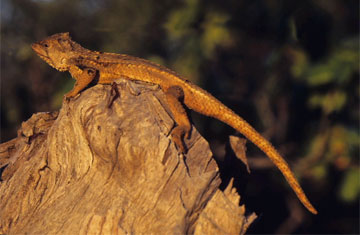Two unknown ‘dragon’ species discovered in Brazil
Two unknown ‘dragon’ species discovered in Brazil
mongabay.com
January 24, 2007
|
|
Two previously unknown species of lizard that are said to resemble miniature ground-dwelling dragons have been found in the threatened cerrado region of Brazil. The species, Stenocercus squarrosus and Stenocercus quinarius are described in the current issue of the South American Journal of Herpetology.
According to Conservation International (CI), an organization that has worked to conserve the habitat were the lizards reside, “the two species are found in a special type of dense savanna, locally called ‘carrasco,’ in dry, flat sandstone tabletops… [which] harbor a mixture of Cerrado and Caatinga plant species.”
CI notes that these ecosystems are being destroyed at a rate of 2 million hectares per year for soybean plantations and informal charcoal production, and warns that by 2030, the only remaining natural cerrado may be in existing protected areas which currently cover less than 3 percent of the region.
  Top: Stenocercus quinarius lizard in Brazil (photo by Cristiano Nogueira). Bottom: Stenocercus squarrosus lizard in Serra das Confusões National Park, Brazil (photo by Andre Pessoa). |
“Time is running out as habitat destruction continues. Future studies on the Stenocercine lizards will provide a much better picture of diversity, as the new species carry unique and very important information on speciation processes that may help to understand the relationships between major blocks of open habitats in South America,” says Brazilian herpetologist Cristiano Nogueira, a biodiversity analyst with Conservation International (CI) and co-author of the paper that first named the two new species.
Nogueira recently completed the largest inventory of Squamate, or scaled, reptile diversity in the Brazilian Cerrado, recording some 253 scaled reptile species, of which 103 are endemic to the cerrado savanna. The survey was funded by FAPESP (the State of São Paulo Research Foundation) and CI.
Related articles
Photos of newly discovered species in Brazil’s Amazon rainforest. Brazil has announced the creation of a Amapá State Forest, a 5.7 million acre Amazon protected area larger than the state of New Jersey. According to Conservation International (CI), a conservation group involved with the creation of the state forest, “the designation protects a crucial section of the Amapá Biodiversity Corridor of northern Brazil, which includes some of the most pristine remaining Amazon forest” and is home to some twenty three newly discovered species.
Brazil’s grasslands could replace food production of American heartland. Today when Brazil is mentioned in the same sentence with “agriculture,” people often first envision the Amazon rainforest giving way to soybean plantations and cattle farms. While the Amazon is being converted for such purposes, the cerrado, a vast area of savanna-like grasslands covering more than 20% of the country’s surface area, is increasingly under threat as farmers from the United States and Europe are setting their sights on the biome’s sizeable agricultural potential.
Hudson Institute fellow calls Amazon savanna biome a wasteland. In an April 21st, 2006 editorial published in the Canada Free Press Dennis T. Avery, senior fellow for Hudson Institute in Washington, DC and the Director for Global Food Issues, called Brazil’s cerrado ecosystem a “wasteland” and criticized a recent report from the environmental activist group Greenpeace that linked Amazon deforestation to soy-based animal feed used by fast-food chains in Europe.
This article is based on a news release from CI.